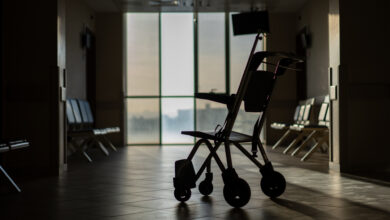Home birth: The new feminist front line
As policymakers and politicians discuss the future of home birth in Australia, a new documentary screening here and in New Zealand illuminates the issues at the centre of the debate and lets women describe their experiences. By Linda Belardi.
As an experienced filmmaker Kate Gorman is passionate about storytelling, and she says, there is no better story than the story of birth.
“When you get a woman to talk about their birth story I find they can immediately go back to that place and recall it in a way that people don’t do when they recall other events in their life. It is absolutely enthralling storytelling,” Gorman tells Nursing Review.
Her documentary, The Face of Birth, co-directed by Gavin Banks, is the result of three years of filming and intensive research, and is an attempt to challenge and redefine Australia’s birthing culture. “Our society has always had an oral tradition of telling birth stories. Today, sadly our folklore surrounding birth is completely based in fear,” she says.
For many women the contemporary story of childbirth is a negative one. It’s a story of anxiety, high rates of intervention, loss of control and narrowing choice – and increasingly postnatal depression and even maternal suicide.
“We don’t often hear birth talked about as an amazing, life changing experience. What we hear now is that it was an ordeal, it was painful even traumatic,” Gorman says. As a filmmaker, storyteller and home-birth mother herself, she wanted to dispel some of the myths surrounding home birth and to speak plainly about the facts around safety and best birth outcomes.
Struck by the stark differences in maternity culture and policy around the world, especially in the UK and New Zealand where home birth is mainstream and government supported, she also wanted to point out the vastly different options that are available to women globally.
Gorman and her team also travelled to the Northern Territory to explore the practices of traditional midwives and the long and sacred tradition of “birthing on country”.
“I have two daughters and I realised that in 20 years’ time they may not be able to choose a home birth, even if they wanted to. I wrote them a heart-felt letter offering them all the information and advice that I could find to help them make empowering choices. This letter became the film.”
Contrary to the fear mongering and often sensationalist reporting on home birth in some sections of the media, the women in this film (which include a shoe designer, head milliner of the Australian Ballet, actor Noni Hazelhurst and a GP), all share their stories of feeling empowered, in control and an equal partner with their midwives in the process.
The film explores the individual choices made by each of the women but many say they were driven by a desire to give birth surrounded by friends and family in familiar environment where they called the shots. The film provides a strong counterpoint to the representation of home birth in the media by giving voice to their choices and birthing journey. Gorman, who is also featured in the film, is part of a small, but growing fraternity of women who have chosen to have a home birth in Australia.
In 2009, there were 863 planned home births, representing 0.3 per cent of all women who gave birth. Of this cohort, 75 per cent were having their second or subsequent baby. Australia has experienced a 33 per cent increase in the number of families choosing to have a home birth between 2004 and 2009.
The Australian Institute of Health and Welfare reported that of the babies born at home in 2009, 99.8 per cent were liveborn.
In January, the tragic death of home-birth campaigner Caroline Lovell was the first case of a mother dying related to a home birth in Australia since 1999. While large studies, including a Dutch study involving more than 500,000 women, have shown that there is no difference in perinatal mortality in homebirths for low-risk women, there is an added risk for complicated pregnancies.
Countercultural women
For childbirth educator, Rhea Dempsey, Australia is living in the labour bypass era where the prevailing birth culture is one where labour is optional and women don’t have to feel pain. “Women who want to have a go are, whether they realise it or not, counterculture women now,” she says.
Indeed, for many maternity lobbyists, home birth itself is a political act. Hannah Dahlen, Associate Professor of Midwifery at the University of Western Sydney, says the contemporary culture around childbirth is one of sacrifice. Modern society tells its women that good mothers “sacrifice” themselves for their babies.
“Women who say that strong mothers and empowered mothers are good mothers shout into this world that doesn’t understand them, and yet it makes sense, the hand that rocks the cradle rules the world,” she says.
Dahlen and Dempsey are among some of the 23 experts, midwives and health professionals who appear in the documentary to debate the core issues. For Dahlen the issue of home birth is so divisive and so complex because it is much more than an argument about safety and perinatal mortality. It cuts to the core of society’s views on choice and agency, women’s rights and trust in birth.
Dr Andrew Bisits, director of the birthing unit at Sydney’s Royal Hospital for Women, describes a strong culture of fear around birth in Australian society. “For whatever reason in our society, the safer childbirth becomes there is almost hand-in-hand an exaggerated fear of things going wrong.
“There is a heightened sensitivity and it colours the way that some obstetricians and midwives view their work. So that becomes an exercise in avoiding complications and risk and there is no attention to the positive side of their work,” he says.
In addition to perceptions of risk, Professor Euan Wallace, director of obstetric services for Southern Health, points to the huge industrial change that would occur under a model of midwifery-led care. “One of the challenges in Australia is that looking after healthy pregnancies is the bread and butter for a large section of the obstetric workforce. It is difficult to relinquish that overnight.”
To contrast the situation in Australia, the film crew travelled to the UK to take a closer look at the maternity services delivered at the Royal United Hospital in Bath which delivers 5500 births each year, with just under 2000 taking place at home or in midwife-led units.
The British midwives working there describe a shift in power dynamics that occurs when a woman delivers her baby at home. The midwife must remember she is a guest in the family’s home. “It’s their game,” says one midwife.
Noted social anthropologist and UK researcher on childbirth, Sheila Kitzinger, says many of the profound changes that have occurred around childbirth can be traced back to the shift in professional responsibility for birth from midwives to obstetricians. “The intervention that started when doctors took over from midwives in the last century… has meant that birth has been seen as an ordeal rather than a challenge or a joy,” she says.
Globally caesarian rates have exploded. In China for example, nearly half of all births are delivered by cesarean section, the world’s highest rate, says the World Health Organisation.
In Australia, one in three births are delivered by caesarian section but experts are cautious about the immediate and long-term impacts of the surgical option.
Sally Tracy, Professor of Midwifery at the University of Sydney, describes Australia’s rates of caesarian section as appalling. “It is shameful and it is rising,” she says. According to her research one in 10 babies born to healthy women by elective caesarian are admitted to neonatal intensive care.
Dahlen says researchers are just beginning to scratch the surface of the aftermath of caesarian section. “The rise in diabetes in children born by caesarian section, the rise in asthma, cancer and behaviour disorders. We are just starting to actually glimpse how we are changing the face of society.”
The extent to which maternity care has ignored the psychological, emotional and spiritual safety of women is also coming to light. “We have a very limited view about safety in maternity care. It is live baby and live mother … but that is just the tip of the iceberg,” says Dahlen.
Postpartum depression is common. Suicide is one of the leading causes of maternal death in Australia and some three to five women per 100 develop post-traumatic stress disorder (PTSD) after birth.
Kitzinger says it is a significant omission that women are not being told that interventions in childbirth can affect physiological outcomes and the interaction between the mother and child. “It is treated as if it is peripheral and rather flimsy information,” she says.
Women are more likely to develop PTSD after pregnancy, she says, if a mother feels like control has been taken from her and she has become the passive object of other people’s decision-making.
Kitzinger says the feelings of helplessness and loss of agency that can be experienced during pregnancy and birth can endure long after the child is born. It can influence many aspects of a woman’s life to a point where that experience has incapacitated her. Kitzinger recalls talking to women in their 60s and 70s who are still troubled by the experience of giving birth. “That helplessness can exist in other areas of her life … she gives up and feels like she is not justified for taking responsibility for anything.”
A positive birth experience can set the pattern for women to begin the parenting journey feeling confident and empowered, she says.
The momentum for change
Independent public screenings of the film have been arranged at universities and hospitals around the country but momentum is gathering for a network distribution. While Gorman is thrilled that maternity professionals have embraced the film, her hope is that it reaches the broader community.
Preferring to be directors and not lobbyists, Gorman and Banks say they have decided not to take the film directly to political and policy circles but believe because of its accessibility it will help generate a change in thinking on the issue.
Gorman says she hopes the film empowers women to feel more informed about the choices that are available to them and ultimately leads to more supported choice for women at a government level. “Women should choose to give birth wherever makes them feel safe and empowered and comfortable, and of course, for many women that’s in a hospital. But I think even for those women they can at least appreciate the right to make a choice.”
For more information see: www.faceofbirth.com
Attitudes of health professionals
Research published last month investigated the views of 20 maternity care providers in Tasmania on home birth.
The study, published in Women and Birth, found that midwives and obstetricians who support home birth do so for three reasons. This included that women have the right to choose where they give birth, that if supported, some women might choose to have a free birth and that home birth is a cost-effective maternity care option.
On the other hand, health professionals who opposed home birth drew upon arguments concerning the safety of the women and babies, and the risks posed to them during a transfer to hospital. Training and philosophy were identified as important explanatory factors for the differing opinions.
Despite the divided views on home births, the study said that health professionals shared a common goal to protect the women and the newborns from unexpected situations during childbirth.
The research led by Ha Hoang from the Department of Rural Health at the University of Tasmania said that more evidence on the safety of home births was needed before government could support it.
Email: [email protected]





